“Catspaw”
Written by Robert Bloch
Directed by Joseph Pevney
Season 2, Episode 1
Production episode 60330
Original air date: October 27, 1967
Stardate: 3018.2
Captain’s log. A landing party consisting of Scotty, Sulu, and Lieutenant Jackson on the uninhabited planet (at least according to sensors) of Pyris VII haven’t checked in for half an hour. Uhura finally gets through to Jackson, who requests a beam-up for himself, and won’t answer Kirk’s questions about what’s happening down there.
Kirk and Spock leave the bridge together, but only Kirk arrives in the transporter room (?), joined by McCoy. As soon as Jackson materializes, he collapses on the deck, dead. A voice speaks through his mouth, warning Kirk that the Enterprise is cursed.
With no obvious cause of death, and no word of Scotty or Sulu, Kirk beams down with Spock and McCoy to the spot from which Jackson beamed up, leaving DeSalle in charge of the ship. They materialize on a foggy plain, even though sensors indicate no temperature variations or bodies of water that would cause fog.
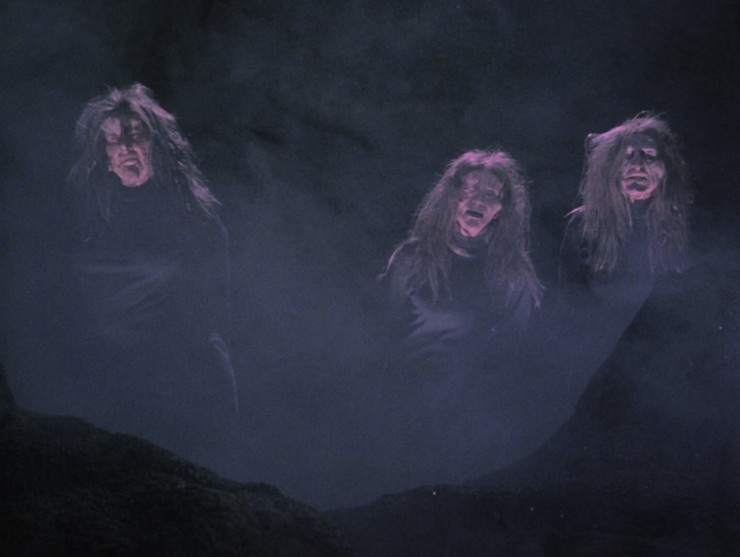
Spock detects multiple life form readings. Kirk tries to confirm it with the ship, but Ensign Pavel Chekov only detects the three members of the landing party—and then the connection goes bad. As they approach, three disfigured women appear and speak in semi-spooky sing-songy voices to warn Kirk to remember the curse and go back.
After they disappear, the landing party heads toward the life form reading—at which point they’re buffeted by an intense wind. Eventually, they come across a castle, which never registered on sensors.
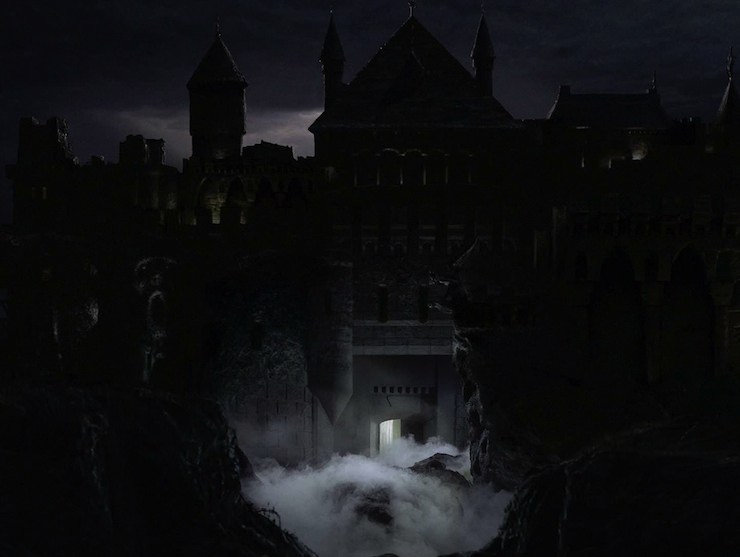
They enter to find themselves hissed at by a small black cat wearing a nice jeweled collar. Kirk and McCoy comment on the Hallowe’en-themed imagery they keep encountering: three witches, fog, castle, black cat, cobwebs. Spock is confused by the reference, but Kirk channels the Doctor by saying he’ll explain later.
On the Enterprise, Chekov loses the signal on the landing party as soon as they enter the castle. DeSalle orders Chekov to retune the sensors (when DeSalle suggests he get help, Chekov gets offended, saying he’s not that green) and Uhura to keep trying to punch through the interference.
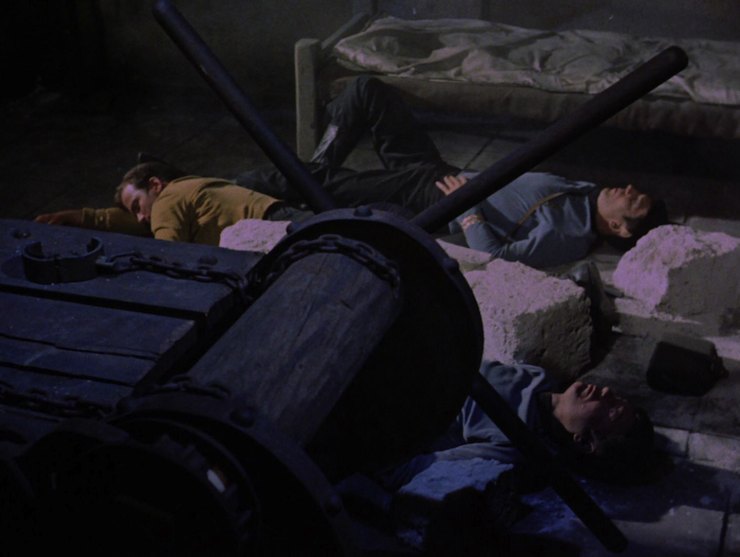
The landing party follows the cat, and the floor collapses beneath them. They fall to the next level, unconscious. They wake up in a dungeon, chained to the wall, along with a skeleton. Kirk is confused as to why they’re encountering so much Earth-based horror imagery on this alien world.
The door opens to reveal Scotty and Sulu, who appear to be drugged, the former pointing a phaser at them. Moving slowly and deliberately, Sulu frees each of them from their chains, Scotty covering them with the phaser.

Kirk and Spock try to jump Scotty and Sulu, but just as they start to, a voice yells, “Stop!” and they find themselves in a throne room. Sitting on the throne is Korob, the cat sitting next to him. He is boggled that Kirk beamed down after being warned away, but Kirk wants to know why Jackson was killed and why Sulu and Scotty are zombies.
On several occasions during the conversation, Korob seems to be getting advice from the cat.
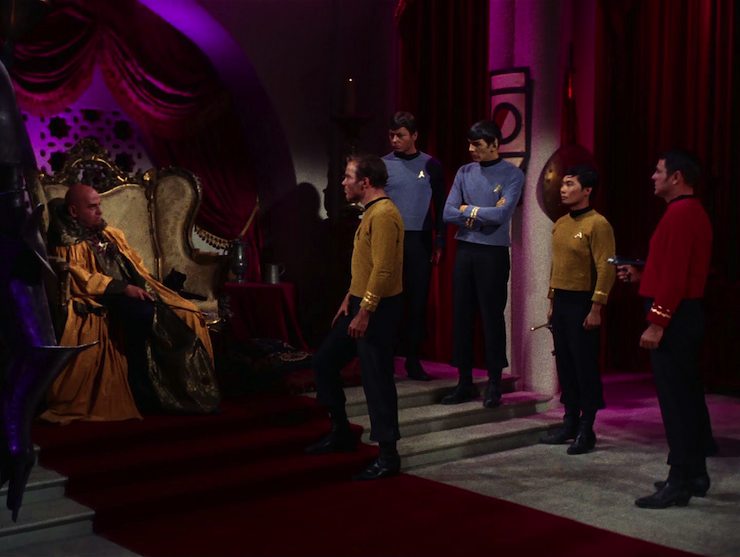
Korob realizes he’s been a poor host and creates a table filled with a feast and insists they sit down and join him. Korob then tries to bribe them with jewels, which fails utterly, surprising Korob. But he then says that they passed the test: they showed their loyalty by not leaving after the warning in order to save their fellow crew members, and they resisted bribery.
The cat runs off, and then a woman named Sylvia enters, wearing the same necklace the cat did. She explains that it was easy to take control of Scotty and Sulu, as human minds are easy to manipulate.
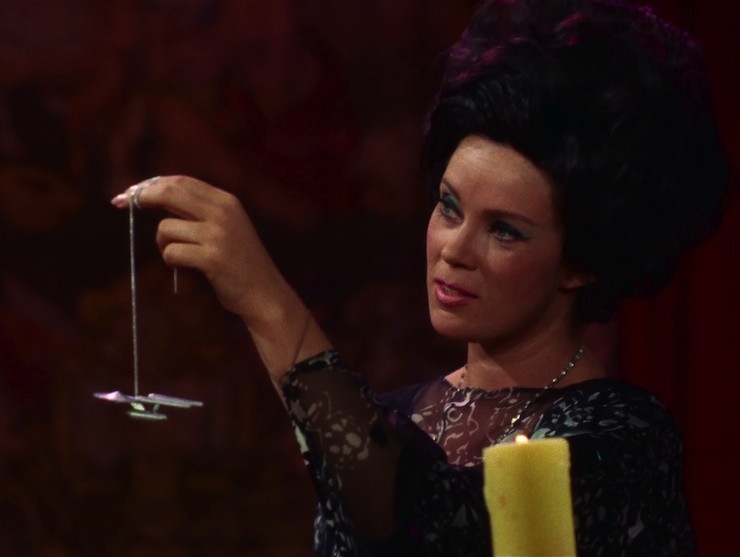
Kirk suddenly jumps Scotty and takes his phaser, handing it off to Spock. Sylvia is unperturbed, and holds a chain with a tiny model of the Enterprise on it. She holds it over the candle and gives Kirk back his communicator. DeSalle reports that the temperature is rising on the ship with no known cause. Unwilling to risk the ship, Kirk capitulates, handing back the phaser. For some reason, Sylvia and Korob want information about the crew.
Korob then encases the Enterprise model in lucite, which translates to a force field that surrounds the Enterprise itself. There will be no attempts by the crew to send another search party down. Sylvia orders everyone save McCoy to go back to their cell.
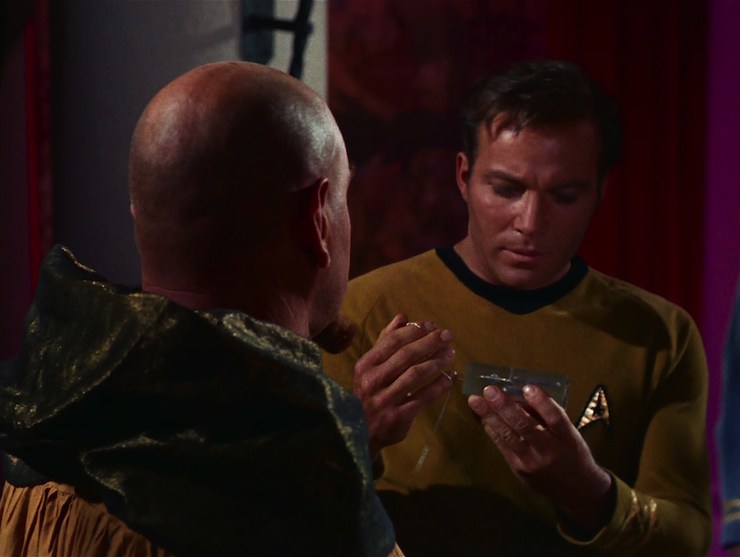
While chained to the wall again, Spock and Kirk hypothesize about Sylvia and Korob, who seemed surprised that they didn’t treat the setting they created as normal. Spock thinks they only accessed the subconscious of the human mind, and created something based on their fears, not their reality.
The door opens, and McCoy has joined Scotty and Sulu in the zombie brigade. Leaving Spock chained to the wall, they take Kirk to see Sylvia and Korob—who are arguing. The sensations that they’re experiencing in human form are quite heady, and Sylvia doesn’t want to give them up. Korob berates her for not following their duty to the Old Ones, but Sylvia could give a damn.
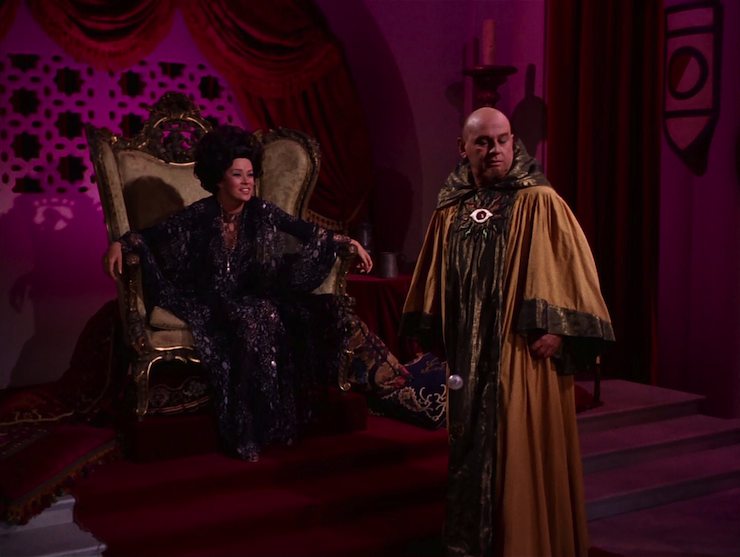
Sylvia talks alone with Kirk. Where she comes from, they don’t have sensations like humans do, and Sylvia wants to know more about how it feels. She offers a melding of their minds—she would get more sensations, and he would get power. (When Kirk asks about Korob, she dismisses him, unaware that Korob is eavesdropping.)
Kirk plays along, being flirty and seductive, and she shows off different costumes and hairstyles. Kirk also learns that they use a transmuter, a device that facilitates their “magic.” Unfortunately, it’s never a good idea to bluff a telepath, and Sylvia reads Kirk’s lack of sincerity in his mind. She angrily sends him back to his cell.
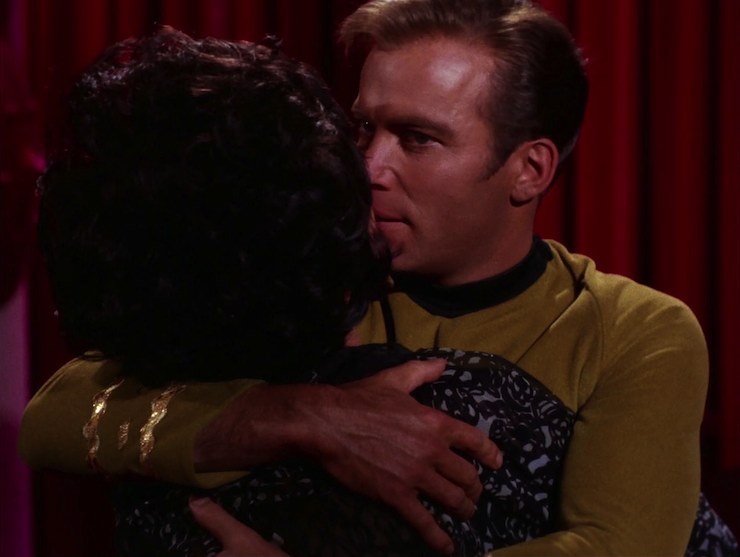
On the ship, DeSalle has been hitting the force field with an electrical charge, which has made a tiny dent in the field. It’s not much—it’s barely even detectable—but DeSalle orders Chekov to keep at it.
Korob comes to visit Kirk and Spock in their cell, freeing them, giving them their weapons and communicators, and saying he’s also freed the Enterprise. Sylvia has become irrational, and Korob begs them to leave—but Kirk won’t leave without his people. Korob insists, however, that they’re not his people anymore, they’re Sylvia’s.
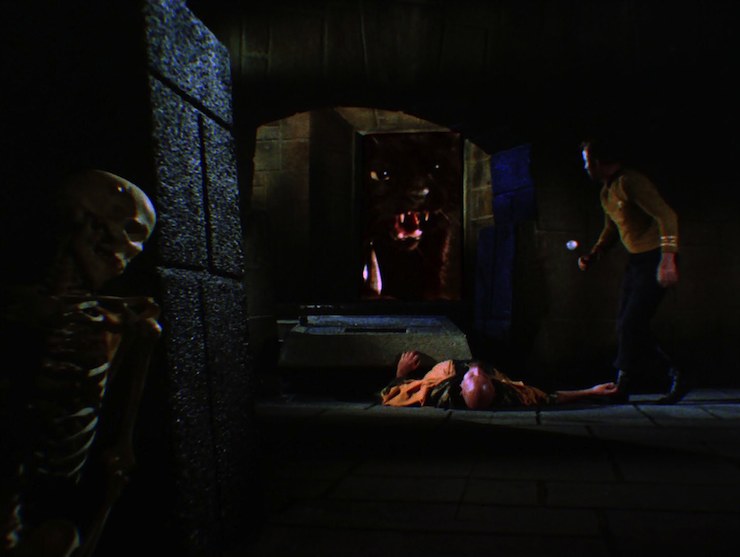
As soon as they exit the cell, though, they’re menaced by Sylvia, back in cat form—but much larger now. She smashes a door that lands right on Korob; before he loses consciousness, he gives Kirk his magic wand, which is apparently the link to the transmuter.
Sylvia sends McCoy, Scotty, and Sulu after Kirk and Spock, but they manage to take them down with mad hand-to-hand skillz and nerve pinches. Sylvia herself threatens them until she realizes that Kirk has Korob’s link to the transmuter. So she takes him to the dining hall, away from Spock and the unconscious crew members, and tries to convince him to give her the transmuter. Instead, he smashes it.
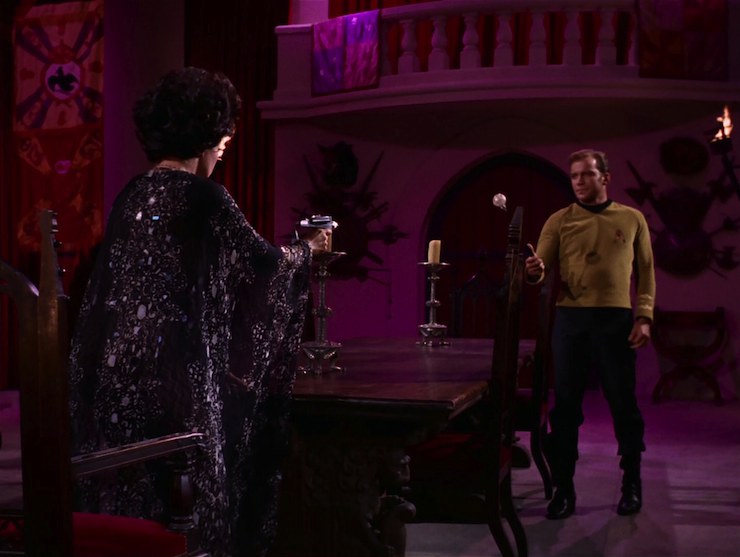
A flash of light, and then it’s all gone: the castle, the fog, the dungeon, all the illusions. They’re just on a barren planet. Even McCoy, Scotty, and Sulu are back to normal. They see Sylvia and Korob’s true form, which are tiny funky alien creatures, who die and disintegrate. McCoy is shocked that this was all an illusion, but Kirk reminds him that Jackson is still dead. And with that, they beam back.
Can’t we just reverse the polarity? The transmuter is powerful enough to manipulate matter and energy to an amazing degree, including apparently providing intergalactic travel, but it’s fragile enough to be easily smashed against a table.
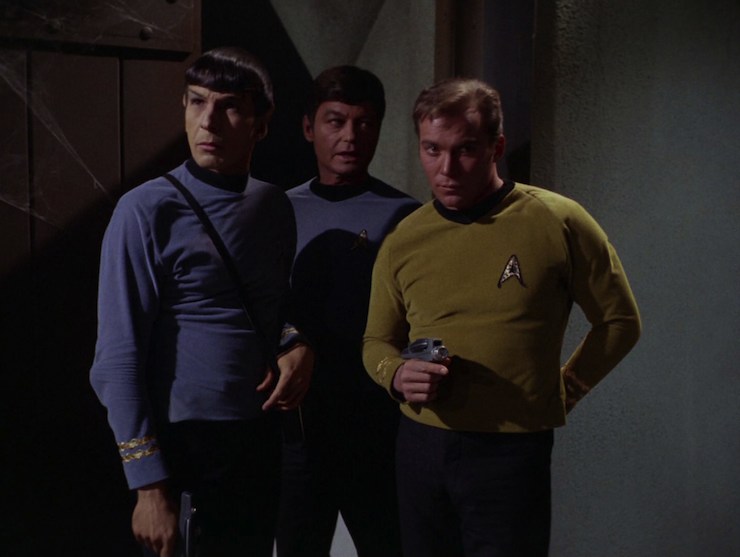
Fascinating. Spock’s notion that Korob and Sylvia intended the setting to be natural rather than fearful belies much of the early parts of the episode, when fear was the obvious motivator: killing Jackson, the fog, and the witches’ warning.
I’m a doctor not an escalator. McCoy gets socked in the jaw twice by Kirk while under Sylvia’s control. Poor bastard…

I cannot change the laws of physics! Scotty gets all of one line of dialogue at the very end. This episode is also one of the few times you can tell that James Doohan was missing part of his right middle finger. He was generally good about hiding it, but when he’s holding the phaser on Kirk, Spock, and McCoy in the cell, you can see that he’s only holding it with his index and ring fingers.
Ahead warp one, aye. Sulu doesn’t even get any dialogue in the episode. While Scotty and McCoy use weapons to beat up on Kirk and Spock, Sulu sticks to hand to hand, and does okay. But Kirk beats his ass anyhow, because captain.

Hailing frequencies open. With both third-in-commands on the planet from jump, and with the new navigator being an ensign, you would think that the ranking officer on the bridge would be left in charge of the ship. But that person is a black woman, and it still is 1967, so they drag DeSalle back (now in the position of assistant chief engineer) to be in command without Kirk, Spock, Sulu, or Scotty around. Sheesh.
It’s a Russian invention! Chekov is added to the cast with this episode to serve two purposes: a younger character to appeal to younger viewers, and also to address supposed complaints made by Soviet viewers and journalists, who decried that Star Trek‘s allegedly egalitarian future didn’t have anyone on board from the nation that was, at that point, the leader in the space race.
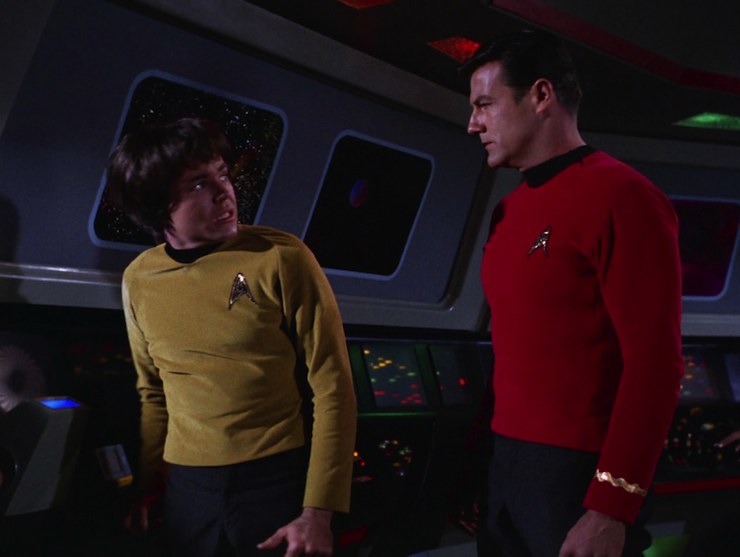
Chekov appears in this episode in a silly wig, which he’d abandon by his next appearance thanks to his hair growing long enough to look like one of the Beatles without help.
Go put on a red shirt. Jackson is killed before the episode even starts, his corpse used as a telephone, but credit where it’s due, his death is not forgotten throughout the episode, and even at the end, Kirk is angry about losing a crew member.
No sex, please, we’re Starfleet. Sylvia thinks Kirk is dreamy, and tries to seduce him in order to feel more things. Erm, so to speak.
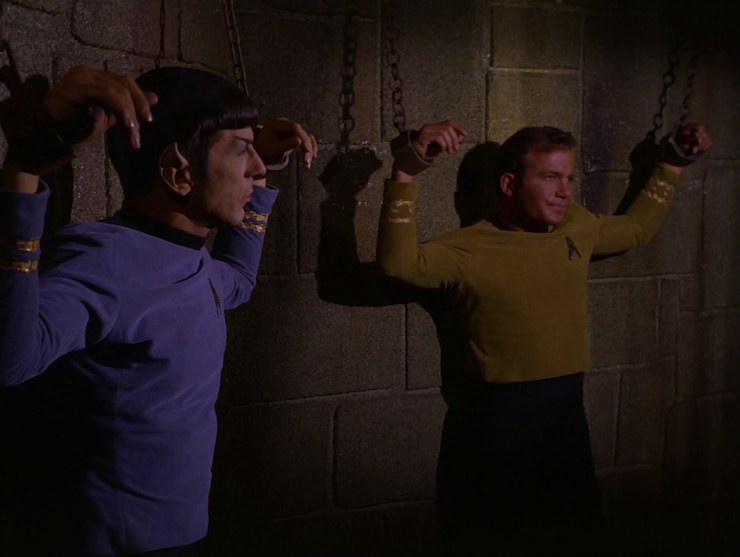
Channel open. “Spock, comment?”
“Very bad poetry, Captain.”
“A more useful comment, Mr. Spock?”
Kirk asking for Spock’s reply to the three witches, and Spock moonlighting as a literary critic.

Welcome aboard. Antoinette Bower plays Sylvia while Theo Marcuse—who died shortly after the episode aired—plays Korob. Rhodie Cogan, Gail Bonney, and Maryesther Denver portray the three witches. Plus we’ve got a brand new recurring regular in Walter Koenig as Chekov, along with usual suspects James Doohan, George Takei, and Nichelle Nichols, as well as the last appearance of Michael Barrier as DeSalle, the first and last appearance of regular stuntman Jay Jones (credited as “Jimmy Jones”) as Jackson, and John Winston as Kyle.
Trivial matters: With the second season, DeForest Kelley is promoted to the opening credits as a co-star along with Leonard Nimoy. In addition, Gene Roddenberry is credited as the creator of the series starting with this season, and the writer and director credits were moved to the beginning of the episode instead of the end of it.

While this episode was produced first, it was held off until Hallowe’en week for reasons that should be fairly obvious.
The witches were supposed to be disembodied heads—which is why they were wearing black turtlenecks—but the effect didn’t work. Hilariously, the 2006 remastered edition did not fix this, though it did show much more of the castle in establishing shots and make Sylvia and Korob’s natural forms look less lame.

Like Robert Bloch’s previous script, “What Are Little Girls Made Of?” there are Lovecrafty references to “the Old Ones.” Bloch based the script loosely on his own short story “Broomstick Ride,” which was published in Super Science Fiction in 1957.
This is the first of two times Trek will have extragalactic aliens who are done in by the sensations of being in human form (“By Any Other Name” being the next), and also the first of two times a creature will first appear as a black cat and then later as a beautiful woman (the next being “Assignment: Earth”).
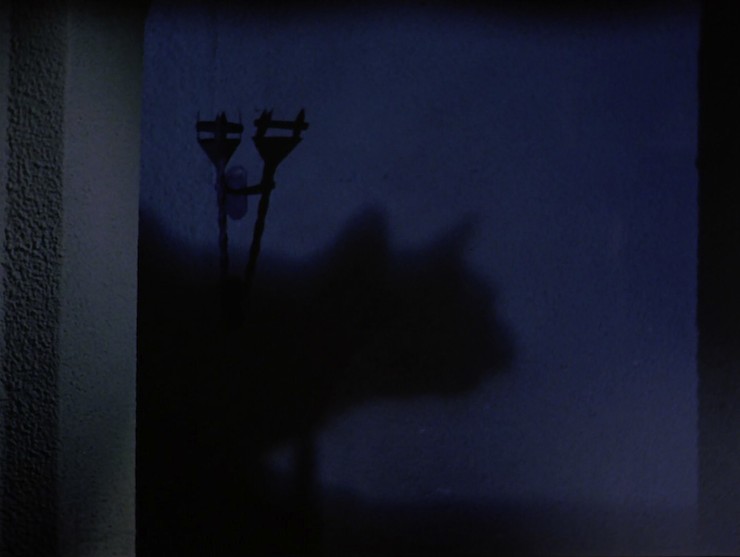
To boldly go. “You can’t think a man to death!” This is the only time in the franchise that they ever did a holiday themed episode, and holy cow is it awful. Korob and Sylvia’s motivations are never made clear, and their attitudes change with the needs of the plot. Sylvia’s hedonism comes out of nowhere just in time for her to have her seduction scene with Kirk, and then it becomes the driving force of the plot. Spock’s line about the wizard and his familiar is brought up just in time for the whole cat thing to be abandoned—and it’s not clear why Sylvia felt the need to be a cat for so long, especially given how much she loves being human in the second half of the episode.
The episode also just looks awful. Every single special effect fails, from the attempt at the witches being disembodied heads to the forced perspective on the cat to make it appear huge (the parts where we only see its shadow work very well—the cat lumbering through a miniature corridor or being superimposed over the doorway, not so much) to Walter Koenig’s hilarious wig to the true form of Sylvia and Korob, on which you can actually see the marionette strings.
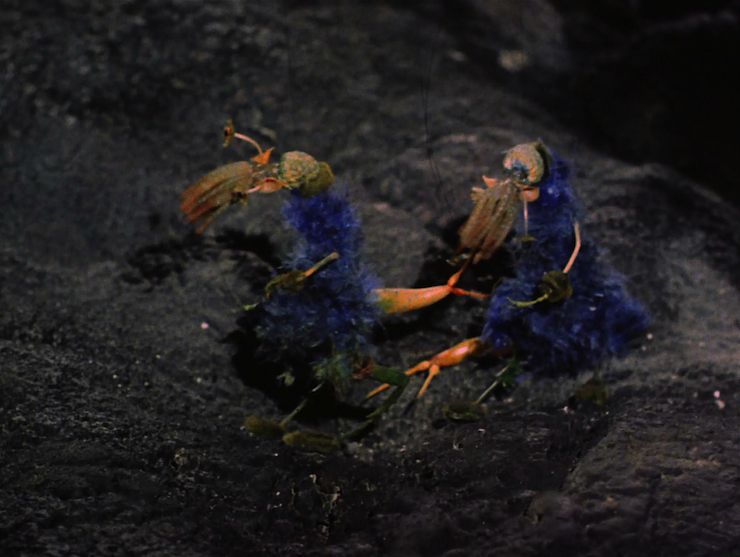
And then in the end they just fall apart after Kirk smashes the transmuter, which you’d think would be constructed just a skosh more sturdily.
Adding insult to all this injury are the scenes back on the Enterprise. As forward-thinking as Star Trek was, this episode is a glaring reminder of how yucky 1967 still was, as they can’t even consider the possibility of Uhura in charge—made infinitely worse by bringing Michael Barrier and his wooden acting back for a third lame hoorah as DeSalle. Nichelle Nichols is the only thing that makes the Enterprise scenes watchable, tortured as we are by Barrier’s wretched line readings (the “I’ll bet credits to navy beans” line is a particular disaster) and Koenig’s comedy wig and comedy accent.
Warp factor rating: 2
Next week: “Metamorphosis”
Keith R.A. DeCandido‘s Heroes Reborn eBook novella Save the Cheerleader, Destroy the World is now available for preorder. One of six novellas tying into the new NBC series, Keith’s tale will be released on the 20th of November, and can be preordered from Amazon, Barnes & Noble, or Kobo.











About the most memorable thing to me from this episode, having seen it when it originally aired, was DeSalle’s “navy beans” line. Everything else was pretty forgettable (fortunately).
Excellent write-up of a not-so-excellent episode. Plus, points for using the apostrophic (?) spelling of “Hallowe’en.” (I always think the word somehow looks spookier with the apsotrophe, even though I rarely use it myself.)
Every time I hear Chekov’s (real world) origins discussed, I hear doubt cast on the Pravda complaints; I noticed you called them “supposed complaints.” Has it ever been established whether they actually happened?
I also didn’t realize, until you were discussing the bad cat effects, how season 2 is bookended by women who transform into feline form.
Spock’s “very bad poetry” line used to crack me up. Then again, I was in middle school when I was introduced to TOS. I know, fart jokes are supposed to make most middle schoolers laugh, but I was demonstrably a nerd.
Forgive the image, but it had to be done:
I confess: I love this episode and always looked forward to it eagerly as a kid, mostly because it combined three of my favorite things: Halloween, Gothic horror movies and STAR TREK. It’s like the “vampire” episode of GILLIGAN’S ISLAND.What’s not to love?
@2 – Mike: Apparently, Roddenberry wrote to a Pravda editor after casting Koenig as Chekov, and only then NBC had a press release state that the character was included in the show in response to complaints in Pravda.
I agree, great write-up!
At least this episode has a few parts that make me laugh. For example, the cat running through the tiny corridor model. And any time we see Chekov’s wig. Oh boy, that thing is atrocious. I can’t fathom how anyone could look at that wig and give it the green light to appear on screen.
I actually sort of like the little Syliva and Korob puppets at the end, in a “look at this cute little thing my kid made for me in pre-school” kind of way. But yeah, this is a pretty bad episode.
The effects are god-awful, the story makes no sense, there’s no motivation. I could go and on….
But this episode commits an even worse sin: it’s mind-numbingly boring. When I watched this, I paused the show every 10 minutes. It took me two days to finish watching it. Ironically, I used one of those breaks to read a Trek novel. I just couldn’t bring myself to finish Catspaw because it couldn’t keep me remotely hooked. Thankfully, this wasn’t the season opener.
You’d think Coon, Fontana and Roddenberry would be feeling fresh from the break between seasons, ready to deliver their best material upfront. But I guess even their talent couldn’t save Bloch’s dreck (and I guess Coon was busy with the much better Metamorphosis).
The way I see it, that’s the problem with relying on freelance assignments. While it’s an effective way to discover potential new talent, there’s a big chance you’re getting a stinker, and in television you don’t have a lot of time to salvage it before you have to shoot it. That’s today’s shows rarely employ freelancers. No offense to Robert Bloch’s writing credentials (which are deserved), but hiring him for Star Trek was a complete misfire for all three episodes.
Luckily, there is one saving grace on this episode: the new musical score. It works pretty well with the cat’s raging sounds during the act break.
Not one of my favorites, but I’ll always have a soft spot for it because of this one exchange:
KIRK: Evaluation, Mr. Spock?
SPOCK: Very bad poetry, Captain.
Love that bit.
Glenn Greenberg
Saying that Bloch based the script loosely on his own Broomstick Ride short story is quite true that story is as muddled a mess as this episode was. i much prefer the Block scripted Wolf in the Fold episode to this one.
BTW The Complete Stories of Robert Bloch, a two volume set, claims to be complete but it lacks at least one tale, That Hellhound Train.
It’s worth noting that Chekov was introduced here as an assistant science officer, and it’d be another couple of episodes before he was established as the navigator. As it happens, that’s basically his alternate counterpart’s role in the 2009 movie. Even though that Chekov sits next to Sulu, he basically functions as a science officer in the story, and only does one or two things that have anything to do with navigation.
And it also means that Chekov is sort of recapitulating Sulu’s career path, since Sulu was introduced as an astrophysicist in the second pilot and was then moved to the helm. Although, of course, Chekov would make another career move to security in ST:TMP.
@2/MikePoteet: As I’ve probably remarked before, I suspect that the creation of Chekov had less to do with Pravda editorials and more to do with Roddenberry wanting to emulate the immense popularity of David McCallum as the young Russian heartthrob Illya Kuryakin in The Man from UNCLE.
@4/Greg Cox: It’s appropriate that you mention Gilligan’s Island, since this episode was scored by that show’s main composer, Gerald Fried. It’s his second episode (“Shore Leave” was first) and he scored every other one of the second season’s opening five episodes (he’ll be back for “Friday’s Child” and, of course, “Amok Time”). It also features the debut of the Kirk theme Fried would use in all three of his season-2 scores, which is most prominent during Kirk’s fight scene in the climax.
I like to think that the giant cat made a return appearance in “For the World is Silly and I Have Chased a Cat” written by our humble rewatcher at Albacon 2002’s “Iron Author / Tin Illustrator” competition.
God, I managed to forget about Chekov’s wig. It was just bad.
Shame the story itself is a mess because I kind of liked the castle and its interiors. But it’s hard to find any logic in the plot, except if we agree to handwave everything as “they are aliens and they wanted to play”. So 2 is about right, the only bright points in the episode for me being “Bad poetry” bit and Kirk’s half unamused, half annoyed facial expression when he’s chained in a dungeon.
As for Pravda story I find it very hard to believe. Gene probably did write his letter, but that was that. The supposed editorial from Pravda was never found even though fans searched for it, and it’s hard to imagine Star Trek being a big enough story to warrant one because general public wasn’t even aware of its existence. In Russia TNG was first shown in 2000 (TOS, as far as I know, was never aired) and before that in Soviet times there was hardly any mention of Star Trek at all. So it seems like it’s a good legend but as a legend it works well.
Another story I always heard about Chekov is that he was the first Russian character on American TV who was a 100% good guy. I wonder if it is true?
This does have a feel of “do we really have to do this?” effort. Korob and Sylvia seem to be some kind of scout force for an invasion from what you can tell when they try to explain their motivations.
Would you really want Uhura doing the part assigned to DeSalle in this episode? Not only is he wooden, he comes off as a more than a bit of a jerk as his command style.
When I was a kid I did not know what “Old Ones” might be referencing, but now, our antagonists “true forms” are supposed to be tiny eldritch abominations tickles me a bit.
Also on the bad special effects, you can see the seam on the top of the dungeon skeleton’s skull.
The whole “Bored aliens create a fake environment based upon props for old movies and half-understood bits of Earth culture” worked much better in Squire of Gothos. Unfortunately the producers didn’t learn their lesson this time and would return to the idea again and again with Specter of the Gun, The Savage Curtain and even on TNG with The Royale.
@12/Darr: See my above comments about Illya Kuryakin from The Man from UNCLE. He was a good-guy Russian who predated Chekov by 3 years (minus a week), and was probably part of the inspiration for Chekov.
@15/SeanOHara: They didn’t really have much choice but to reuse the premise, since coming up with excuses to encounter Earth cultural elements in space was key to making the show affordable to produce. It was actually built into the original series pitch that parallel Earths would be encountered frequently. And having aliens draw elements of Earth culture from the crew’s minds makes more sense than having them just randomly be an identical parallel as in “Bread and Circuses” or “The Omega Glory.”
The main redeeming quality of this episode is that the stardate happens to be lower than the one in Space Seed, making it easier to justify Khan knowing Chekov in TWOK.
Other than being a main character (and her first season yellow uniform) is there any reason to believe Uhura is in the chain of command? Although she’s an officer and later established as having attended the Academy there is noting that indicates she has specific command training. Plenty of real-life Navy lieutenants would not be given command of a ship under routine circumstances
I didn’t think it was that bad, and remember the old TVs didn’t have the resolution nor signal we have now.
Theo16 @17- Since at least the days of sail, the line after the Captain would be:
Designated second-in-command (most senior line officer)
Highest ranking line officer; if there are more than one of a particular rank, then whoever has the most time in that rank in the ship’s company
If you’re down to petty officers and seamen, command succession is likely the least of your problems.
“Line officer” is generally those trained in leadership, navigation, ship’s systems, weapons, etc. Doctors, dentists, lawyers, and passengers are typically excluded. Flag officers embarked can give missions and advice that would probably be listened to.
Uhura in command makes as much (or as little) sense as Scotty being in command.
—Keith R.A. DeCandido
@7/Eduardo: I agree. The problem is not that it’s nonsensical or disjointed, but that it’s boring.
@15/SeanOHara: Why should the producers learn a lesson about fake environments created by aliens? That’s neither better nor worse than any other plot device, and I liked the way it was used in Spectre of the Gun. They might have learned a lesson about not employing Robert Bloch, though.
@17/Theo16: You mentioned that in the Where No Man Has Gone Before rewatch. And people answered that stardates vary depending on where poeple are, among other things, and that Chekov could have worked anywhere on the Enterprise before. So, no redeeming qualities :-).
@17 et al: Uhura in command would have been so cool! Thankfully, a lot of novels have done it since then.
Since nobody else has mentioned this: When Kirk wakes up in the dungeon, he calls McCoy “Bones”, then sees the skeleton chained next to him and switches to calling him “Doc”. Which he keeps up for the rest of the episode, except for his initial reaction when he sees McCoy newly zombified. I thought that was reasonably funny.
@9 – Nicholas: Wolf In The Fold? Ew, no. Woman-hating Scotty…
@12 – Darr: Not only ST didn’t air in Russia until 2000, it was first shown in Germany in 1972 (where a Soviet journalist could have conceivably seen it by chance). You would have to have a Pravda journalist on assignment in the US, who just happens to catch a first season TOS episode on TV… Maybe he was in England? Well, BBC started airing TOS in 1969… so the legend keeps getting more and more implausible.
15 – Sean: I liked “The Royale”. :)
@5/lordmangusen and @10/Christopher – So there was never any mention of the show in Pravda, before or after the decision to create and cast the role? Christopher, your theory sounds like Roddenberry to me — wanting to follow a trend but denying that was what was going on.
@17/Theo16 – Other than being a main character (and her first season yellow uniform) is there any reason to believe Uhura is in the chain of command? I have a memory of Nichelle Nichols saying that Roddenberry told her Uhura was fourth-in-command, and she has repeated this in numerous interviews (I believe) as evidence of Trek’s forward-for-its-day thinking; but it sure seems like Sulu gets the nod every time we have to go below Scotty. I don’t believe anyone tuning in Star Trek on NBC in the 60s would have come away with the impression, “Wow, a black woman is fourth in command of the ship.”
@20/Jana – Peg Robinson even made Uhura a captain and gave her a ship of her own in her short story in Strange New Worlds II. And nice catch on the “Bones”/”Doc” switch – I had forgotten about that. (I reread Spock Must Die! recently, and was annoyed no end that Blish, inexplicably, has Kirk always calling McCoy “Doc.” Maybe the story is set not long after “Catspaw!” <g>)
@17: Stardates, particularly during the original series, are more trouble than they’re worth. In Spock’s Brain, Kirk voices two completely contradictory stardates within 20 minutes of each other. TNG’s first season is also a mess in terms of stardate consistency. Some of that could be the actor messing his line delivery. I recall Riker giving an illogical 4 digit stardate on Datalore.
I often wonder what was the process for the writers whenever they picked a stardate for a script. Someone had to keep track of that. I’m guessing Fontana. Nevertheless, I can see why the DS9 writers gradually veered away from the stardate system (the series finale didn’t have one).
@22 – Mike: Apparently, no one has been able to find any mention of Star Trek in Pravda.
@23 I recall reading somewhere that at least some writers used the episode number to figure out the stardate.
MikePoteet: Actually Sulu was the third in command before Scotty ever was. The first and only time Scotty was in command of the ship in the absence of Kirk and Spock in season 1 was “A Taste of Armageddon.” But Sulu was put in charge of the ship in “Arena” and “Errand of Mercy,” and also watch “The Man Trap,” “Tomorrow is Yesterday,” and “Balance of Terror” again — Sulu in each of those episodes is acting like he’s the second officer, third in command of the ship. It wasn’t until the second season — when George Takei was away for some time filming The Green Berets — that the notion of Scotty as third in command took root.
Also to MikePoteet: Blish had it as “Bones” in his manuscript, but the editor changed it to “Doc,” thinking that no one would call a doctor “Bones.”
—Keith R.A. DeCandido
This is for me the episode that best demonstrates what STAR TREK would have been like produced by Irwin Allen.
@18 Good point about how 1960’s TV broadcasting and reception covered a multitude of sins. Watching TOS episodes that have been remastered and in Hi-Def reveals things like wood-grain under the paint on the bridge consoles, or the heavily caked-on makeup on the actors. I also remember watching “The Naked Time” and noticing that the embossed pattern on the translucent plastic hazmat suits bore a suspicious resemblance to a shower curtain we used to have.
I will give the episode this, the stuntman playing Jackson deserves a bonus for going just completely *splat* off the transporter pad in the opening, it never fails to impress me.
@26/Keith – Interesting point about Sulu and Scotty – I never realized that. And I certainly never knew that Blish was right all along. Those darn editors! <g> (It also makes me wonder, again, why Trek 09 had to give us such a convoluted origin for McCoy’s nickname… I guess the filmmakers thought modern audiences wouldn’t know about “Sawbones,” either?) Thanks for the info!
Re: the chain of command
Maybe someone thought Scotty was an Engineering Duty Only officer, haha.
But I put no stock in the uniform colors. If Spock, the First Officer/ second-in-command can wear blue, then I won’t justify or argue against based on colors. Especially when Starfleet apparently decided to, you know, swap colors between Star Trek and TNG.
I would be fine if it was a fashion choice. We never saw the midwatch crew; they could’ve worn purple wigs for all I know.
I saw this as a kid of the scared-of-her-own-shadow type, and it didn’t scare me. And images from human subconscious? Sorry, he was using fairy tale stuff–wizards and witches and cats and stuff–and I’d never had a nightmare with wizards or witches or cats and stuff.
Now, if you want to talk about nightmares with killer robots attacking kids, OK, I’d had that one.
Korob and Sylvia’s true forms are a lot more effective in black and white, by the way. Cuzzy, Cookie Monster blue is not a scary color.
All I could figure out about how fast they died was that they must be from a really different planet and couldn’t even breathe on that one once they were in their real shapes.
Sorry, the above should read, “Fuzzy, Cookie Monster blue is not a scary color.”
@20 JanaJansen–Can you recommend particular novels in which Uhura gets to be in command of the ship?
@22/Mike: I missed out on the entire Strange New Worlds series. Thanks for calling my attention to it!
@34/Saavik: In most of the novels I’ve read it’s not a major plot element.
In Diane Duane’s The Wounded Sky, Kirk leaves Uhura in charge when beaming down to Starbase 18 even though Sulu would be available too (Chapter 2). Nothing happens, but it’s a nice touch. The book contains lots of those, e.g. Kirk being glad that the female engineer K’t’lk is a spider and not a human because she and Scotty become good friends very fast, and he would “hate to lose Scotty for paternity leave”, or people from the starbase wishing the Enterprise “Goddess’-speed”.
In both of Dave Galanter’s novels, Kirk leaves Uhura in charge when he has work elsewhere on the ship, again even though Sulu would be available too. In Troublesome Minds, it’s just briefly mentioned (Chapter 3), in Crisis of Consciousness she’s responsible for repairs and explains to Sulu why she nevertheless repairs the communications console herself (because it’s her job to assign the best qualified person to the task).
None of these books is about Uhura in command. Still, they’re all good books.
The only novel I know where Uhura in command plays a major role is Greg Cox’ The Weight of Worlds. It has three narrative threads, one about Kirk and Spock in a different universe, one about Sulu on the surface of a planet, and one taking place on the Enterprise, with Scotty in command. But then Scotty gets injured, and this automatically places Uhura in command because she’s the senior officer. (The novel even explains why DeSalle is not available.) She stays in command until Kirk gets back 200 pages later, and she really gets stuff to do, with an enemy threatening the ship and the landing party. Also, Charlene Masters from The Alternative Factor is in charge of engineering, so that’s another benefit.
On the other hand, it’s all a bit silly, probably deliberately so – the adversaries are a cross between Aztecs, crusaders, missionaries and Douglas Adams’ Krikkiters, and the situation is resolved through a combination of a ball game and a mind meld. The book contains a lot of episode references of the “Kirk was reminded of” variety. And I found the Sulu subplot rather dull (it’s mostly about fighting). You decide if it’s your cup of tea.
@30 – Mike: I don’t mind the nuTrek origin of the nickname Bones, it’s cute. Plus, you can have it both ways, he can be called Bones because his quote, and because he’s a sawbones.
@35 – Jana: You think that paternity leave thing is a nice touch? I think it’s horrible, it’s implying Scotty couldn’t keep it in his pants if he was assigned a female engineer to work with.
@36/lordmagnusen: Actually, Kirk is more amused than worried in that scene – his thought is supposed to be tongue-in-cheek. I guess my side note was too short to convey that. Also it doesn’t apply to any female engineer, only this particular one, because they get along so well right away. To be totally precise, Kirk has this thought because K’t’lk uses Scotty’s first name very soon. It doesn’t have anything to do with Scotty’s behaviour at all.
And it’s a nice touch because it implies that “paternity leave” is something normal for Kirk, suggesting both that people can have children and still work, something never suggested in the actual show, and that it’s as normal for the father to take a leave as it is for the mother.
It’s a cute book. Really.
Gotcha.
@23/Eduardo: On TNG and its successors, the job of keeping track of stardates fell to the script supervisor. That may have been the case on TOS as well, but I have the sense it may have been Bob Justman’s job when he was around.
@30/Mike: I think the movie changed the “Bones” origin for several reasons. Modern audiences’ lesser familiarity with Westerns may have been part of it, but I think a lot of it was just efficiency. Movie storytelling needs to be concise and stripped down, with no excess. Some random digression into Old West nicknames for doctors would’ve been a pointless distraction. The line they used combined both the establishment of McCoy’s divorced status and the origin of his nickname in a single sentence, which is a lot more efficient.
And lordmagnusen is right — Kirk could’ve latched onto the “nothing but my bones” line because it reminded him of the “Sawbones” nickname. So it isn’t necessarily a contradiction, just an elaboration.
@34/Saavik: The first time Uhura took command was in the animated episode “The Lorelei Signal,” when all the men onboard were incapacitated. The later animated episode “BEM” implied that she was commanding the bridge while all the male leads were otherwise occupied, but she was only shown standing beside the command chair, so it was ambiguous.
On top of all that, the scene where we’re introduced to Karl Urban’s delightful McCoy is simply one of the best parts of the movie.
Woo-hoo that was a bad one! Wretched effects, ridiculous plot and cheap sets make this one the biggest stinker of the Second Season. Luckily, it’s all up hill from here.
@39/Christopher: Wouldn’t that be the script coordinator’s job? As far as I know, the script supervisor keeps track of the visual continuity for editing purposes, rather than the pre-production aspects.
I don’t recall who had that job in the Original Series, but in TNG, as well as DS9 and Voyager, that was Eric Stillwell’s role. It certainly was throughout Michael Piller’s seven year tenure as executive producer, plus Insurrection.
@42/Eduardo: You’re right, I meant script coordinator.
RE: krad saying that this was the only holiday-themed episode…although it was never advertised as such, I always felt that the Voyager episode “Twisted” had a Halloween-y vibe to it, and it did air in October.
@sps49 #31 I always took Spock’s blue uniform to be because he was chief Science Officer in addition to being Executive Officer. Most of the time, Kirk introduced him or referred to him, it was as Science Officer, not XO (although I’m sure there are some examples otherwise). I would assume it would be Spock’s choice which to wear given he had duties in two different departments. Given that he always considered himself a scientist first (his “…as a teacher, I am content to command the Enterprise…” comment in TWOK as an example), his wearing blue instead of green/yellow/mustard/puke is, well…logical.
@44/DonRudolphII: I think the formal name for the color of the command uniforms is avocado green (although the fabric looked more gold under the stage lights).
@35 JanaJansen–Thanks much for elaborating on the novels where Uhura gets to command the ship. I’m sure I read The Wounded Sky years ago, but I had forgotten that plot point (understandably, since as you say nothing happens while she’s in command). I will check out Galanter’s books, and take a gander at The Weight of Worlds.
CLB @46- And for TNG they gave up and used blue, a darker red, and a definitely not-green yellow. No more ambiguity!
the bad cat effects is terrible
Welp, as I said, this one is a guilty pleasure. I like watching it mainly because it’s the actual first episode of the second season, it introduces Pavel Chekov (silly wig notwithstanding), and it has that great season 2 music. But bowhowdy does it irk me that Uhura couldn’t be in charge (stupid 1960s racism and sexism), and DeSalle is boring as all get-out. But I actually enjoy the stuff on the planet. Yes, the effects are pretty terrible, but I guess I enjoy the feel of the episode, everybody in their spiffy new season 2 uniforms that fit much better (even the rank insignia is more organized) and some great music that would be used again and again and again. The worst part of the episode for me is Michael Barrier. Whoo is he boring (yeah I know I already said that).
@17 Uhura is a senior bridge officer, so yes she is part of the chain of command, established by Roddenberry himself (1960s idiotic racism and sexism notwithstanding), so yes she should have been in command.
Yay, season 2! Looking forward to next week for one of my favorites, “Metamorphosis”.
@48/sps49: My understanding is that in TOS season 3, they stopped using the velour fabric (whose sheen made the avocado uniforms look gold — Kirk’s green wraparounds were of a different material) and started using an actual greenish-gold color to match the onscreen appearance of the old tunics.
In TNG, the specific uniform colors they used were burgundy, teal, and mustard, according to a behind-the-scenes magazine article I read way back when.
Avocado green? Yeah, they look yellow on screen, and I’ve always seen them referred to as “command gold”. As for TNG colors; I recently acquired an official merchandising hoodie; and it said that the red/burgundy color of the fabric for this consumer garment is mean to be screen accurate, as opposed to “prop accurate”, because IRL the red uniforms would be ridiculously bright, and not match what we see in screen, IE “what’s actually from the Star Trek universe.
Did they anticipate that the green would look gold on screen, or did they intend the uniforms to be green, and we were just lucky?
@52 @53 It occurs to me that since many viewers at that time would still be watching the show on black-and-white TVs, some of the color choices for uniforms, sets, etc. may have been determined by what would also appear in good contrast for those not seeing it “in living color” on NBC. I’ve read that such color choices were taken into consideration at Hanna-Barbera for their cartoon shows in the 1950’s and 1960’s..
@53/Jana: How it looked onscreen was no doubt a consideration. One of the main reasons they chose the colors they used was that most viewers still had black-and-white sets at the time, and they wanted to make sure the colors were distinguishable in black and white. So they probably wanted the three colors to have significantly different brightnesses.
Again, though, Kirk’s wraparound command tunics were the same color but a different, less shiny material, so you can see the true color in them.
So if we were to hold in our hands the original avocado green uniforms, and Kirk’s wraparound from S3, they’d be the same color?
@35/Jana – You’re welcome! There are a lot of good stories in those volumes. I particularly and shamelessly commend “The First Law of Metaphysics” in SNW 2 to you. Still available as an ebook… makes a great gift… ;)
@36/lordmagnusen – But it makes no sense! Who talks that way? “All she left me was my bones?” Wouldn’t you say, “All she left me was the shirt on my back?” We agree to disagree here. :)
@57/MikePoteet: How is it bad that McCoy is creative enough to avoid a hackneyed cliche? “All she left was my bones” suggests a far more extreme and savage outcome than “the shirt on my back.” It’s quite evocative, far more so than the worn-out stock expression.
Besides, he is a doctor, so why wouldn’t he be more inclined to use anatomical idioms than the average person on the street?
The problem with “Why isn’t Uhura in charge?” argument is that absolute rank is pretty irrelevant on a naval vessel. The original STAR TREK, written and airing during a time where a large portion of the staff were veterans (Roddenberry himself was a lieutenant in the Army Air Force during WWII), was good on this versus later iterations (and particularly ancillary material). Command in lieu of the captain is held by an officer of the watch who either has that shift or is assigned the deck or conn when the captain or Officer in Command needs to be elsewhere. Many of the top officers, including those steering *would* be trained as OotW/OotD (including on stations such as Engineering Watches, where real-life naval officers tend to accrue command experience aboard ship), so seeing Kirk his XO Spock, the heads of the Engineering Department, Sulu all having watches in the big chair makes perfect sense. Meanwhile, Uhura, despite her higher rank and frequent presence on the bridge, isn’t necessarily going to go through that training any more than other non-section heads or officers not used to steering/controlling (via engineering controls) the ship would – consider for example McCoy, who’s got the high commission of a civil professional (like doctors drafted or enlisted into the military in the real world) yet isn’t trained to command the bridge.
THE NEXT GENERATION actually shows a few good moments regarding this. You get glimpses of the “schedule” of watches (in particular how Data seems to hold extra command shifts due to not having to sleep), as well as the idiosyncrasy of LaForge seemingly NOT having the same bridge credentials as Scotty (note how he transfers to Engineering and ends up as Head of Engineering Department, but his position as Chief Engineer is always shown as different that Scott’s, as if those other engineering officers are still heading up the actual watches). Meanwhile, we actually see the training of Crusher and Troi for bridge duty. While rank allows someone to, literally *call rank* in emergency (notice how often in any series a superior office jumps into an open seat, for example, or even how an Admiral tries to call rank on a Captain whose ship he has no claim on), the prerogatives of command in case of things going wrong depend on having the right qualifications so the de facto captain is the de jure captain acting on (at least assumed) orders instead of someone just pulling rank and doing what they choose to.
(Despite not being a vet myself—my attempts to enlist back in the day being 4F’ed by the extent of my migraines—I ended up actually having to take a version of the navy’s Officer of the Watch training while working on a museum ship still under naval contract, since they required someone on board qualified to technically be holding the bridge/conn in case of emergency, and I had enough crossover knowledge from curatorial/historical training to understand what to do. So, ironically, in case of a “Tomorrow Is Yesterday” situation, I might actually come before Uhura myself in bridge precedence depending on how continuity-of-forces follow… ;) )
@59/bhaughwout: But that isn’t a refutation, is it?
In-universe, Uhura might have had command training or not. Nothing has been established at this point.
Out-of-universe, she’s the only one from the main cast who isn’t on the planet, so why not use this episode to establish that she has been trained to command the bridge and put her in command?
bhaughwout: As JanaJensen said, though, ultimately it boils down to “they didn’t put her in charge because she’s a black woman.” There really is no other reason for it, and we can pull justification out of our posteriors all day and it still boils down to “they won’t put a black woman in charge of the ship for a 1967 audience.”
—Keith R.A. DeCandido
About shirt or bones, in my country, when someone (be it your ex-wife, a thief, or a business partner) takes everything from you, we use the expression “she/he left me buck naked” (actually, it’s “me dejó en bolas”, which literally means a certain part of a man’s anatomy was left out in the open).
Only just now saw that Bruce Hyde, who played Lt. Kevin Riley, died last Tuesday.
FWIW, although folks have been referring to the “gold” shirts as avocado green, this interview with Bill Theiss claims they are lime green, though that particular bit isn’t a direct quote.
Going back to the costume discussion from the “A Taste of Armageddon” comment thread, an interesting point in that article @MeredithP links in #64 is that Theiss identifies the article of clothing worn by Uhura and other female crew members both as a skirt and as a “skant.”
One more Gilligan’s Island connection. Korobs robe is used again in an episode of Giligan’s Island called ” Lovey’s Secret Admirer” Worn by Bob Denver as he plays Mrs. Howell’s fairy godfather in a dream sequence.
Watching this episode again, I just spotted something that I had never noticed: Kirk uses a very strange pronunciation of “telekinesis”. He pronounces it “tele-KIN-esis” instead of “tele-kin-E-sis”, which is a pronunciation that I’ve never heard before.
@67/cScott: Apparently that’s the British pronunciation. Maybe Canadian too?
For me, the most frustrating thing about this episode is it wasted Antoinette Bower with a bad script. I think she had the potential to be remembered as one of the most evil and seductive Trek women, but as krad noted, her motivations are all over the map, depending upon what the plot needs. I mean, the writers/director could have done a better job of demonstrating that she was controlling the zombified crew members, as opposed to them just being in a generic evil trance.
Instead of her wanting Kirk to ‘rule’ with her, it would have been more fitting for her goal to be to put him in the same zombified condition. It’s interesting to note that in the 1967-68 TV season, she appeared on the season premiere of The Invaders, also as an evil alien temptress.
@66/David: Actually, it’s the other way around: the Gilligan’s Island episode you referenced aired in January 1967, so that came first, and this reused the robe that was originally Gilligan’s.
My son and I just rewatched this episode, I had Googled “I’ll bet you credits to navy beans”, as being a Navy man I never heard that one but it sounds military somehow.
The comments about the marionette strings and the witches heads— keep in mind, no one had HD TVs in the 60’s/70’s/80’s/90’s. They could get away with a lot because the viewer at home would never see it.
I read about this episode as a child in The Monsters of Star Trek (you’ll hear that a lot from me as I comment on these) and thought it sounded so cool and eerie. Then I watched the damn thing and I’m still cringing.
I didn’t see it commented upon in the review, but what bothered me the most was how Sylvia is implied to have lost control because she’s female and thus controlled by her passions. It’s unpleasant even by The Original Series standards and one of the episodes that make me want to skip ahead to The Next Generation like a friend suggested to me.
@72/Fujimoto: Just skip everything written by Robert Bloch.
@72/Fujimoto: “what bothered me the most was how Sylvia is implied to have lost control because she’s female and thus controlled by her passions.”
I never got that impression. Korob just says she’s irrational because of “the strain of adapting to your form, the insatiable desire for sensation and experience.” It seemed more like an innate difference in her and Korob’s characters, one that existed before they adopted human forms and genders. Yes, Sylvia emphasizes that she’s a woman, but she’s doing that to tempt and manipulate Kirk — and Kirk rejects it and says she’s not truly a woman. So I don’t think her cruelty and avarice are being blamed on her adopted gender — the opposite, if anything.
Granted, a lot about the episode fits into the standard ’60s trope of the female seductress luring men astray with her predatory passions, of women as creatures of passion by nature and thus dangerous to male self-control, but I don’t see that being made textual in the case of “Catspaw.” Even if it was an intended implication, it’s easy enough to disregard, since nothing in the text requires it to be the case.
@28/Russell H: It doesn’t take remastering to see that the “hazmat suits” are shower curtains in The Naked Time ;)
@30/MikePoteet: I’m with 36/39 on the “Bones” origin. I liked its inclusion in Star Trek 09 even though there was the obvious “Sawbones” connection. It’s clever mix of both. I also thought the divorce was a believable McCoy story and gives some perspective on McCoy being out in space considering he often doesn’t seem too thrilled about it.
@50/CLB: As a Canadian, I’ve never pronounced telekinesis the British way, but then I also never said “eh” in my life until after I heard that Canadian stereotype. So I guess then I’m not the best authority on it, haha.
I’m not saying the special effects are good or the plot isn’t corny but like this one. Shoot me!
Of course Chekov was wearing a silly wig. He was going trick-or-treating later.
“Catspaw” is truly a bad and goofy episode but nonetheless has its entertainment value and moments of hilarity. Almost nothing in this episode, and I won’t bother listing all the absurdities and inconsistencies. Yet, there are great-funny lines galore: “A bit more alacrity if you please, Captain;” “You’d be a natural [for trick or treat]”; “I’m not that green;” “You can’t just THINK a man to death” and, of course, “I’ll bet you credits to navy beans!” But I think my favorite moment is when the robotic Scott, Sulu and McCoy attack Kirk and Spock with axes and are easily and pathetically defeated. Oh, and the stuntman for Sulu is Asian, but he’s much older, shorter and fatter!
@78/Gooch: I agree, I’ve always found this episode entertaining regardless of its many faults.
I just first-time watched this episode. “Blech!” is my assessment. It felt like such a stretch for a Star Trek episode because it seemed to be tailor-made to fit a Halloween theme. And that’s a dumb way to construct an episode: based on a holiday! Good thing they never did a Valentine’s Day episode or a Christmas episode.
Everything was just so silly to the point that the only enjoyment I got was probably from unintentional humor: from Chekov’s atrocious wig, to Sylvia’s costume and appearance changes like she was on Bewitched, to the manly man Kirk being so fetch that Sylvia can’t help but be seduced by him. I did really like the line from Chekov about him not being green. He’s such an iconic character from TOS and I’m really glad he was added to the cast.
I would have never known about James Doohan’s missing finger if it wasn’t pointed out to me or I hadn’t read about it. It’s not something I would have ever noticed from watching this episode.
I’ve seen “Assignment: Earth” before this one and multiple times (much better episode) so I also caught the similarity, but in reverse, of yet another black cat that takes “beautiful” human female form.
I also caught the similarity of this episode with that of “By Any Other Name” (again, a better episode than this one) where the aliens are really enjoying being in human form and don’t want to leave it.
And this episode also falls into sexist territory, not just for not allowing Uhura to be in command, but Kirk makes yet another reference to how women are supposed to act, and Sylvia is no woman because she doesn’t fit Kirk’s definition of one. It’s all so yucky and makes me want to throw on TNG instead where writers of that day were a bit more enlightened.
@80/garreth: “And that’s a dumb way to construct an episode: based on a holiday! Good thing they never did a Valentine’s Day episode or a Christmas episode.”
Tell that to the countless TV series before and since that have done holiday-themed episodes. For many shows, it’s an annual tradition. I don’t see how it’s dumb. Commercial TV survives by getting good ratings. Tying into ambient holiday spirit is a logical way to try to attract viewers that might otherwise be too distracted by the holiday to watch their usual shows. It may not always arise organically in-story, but in real-world terms, it’s an entirely reasonable decision.
I believe that “Friday’s Child” was intended to be a Christmas episode in an indirect way. And “Charlie X” mentioned Thanksgiving, though it aired in September.
“to the manly man Kirk being so fetch that Sylvia can’t help but be seduced by him.”
The idea was that Sylvia was seduced by her human urges and drives. Kirk just happened to be the most appealing target available.
@80/81: “Dagger of the Mind” also mentioned a Christmas party.
@81/CLB: I realize that doing holiday-themed episodes is pretty standard in American television programming and that can work fine for a lot of series. And often times it does work out fine so I shouldn’t have called it dumb. But rather, I meant for Star Trek, I saw it as a rather poor fit as I see this drama as more serious, high brow fare. Therefore, doing a Halloween-themed episode seemed very silly to me as if the producers were trying to appeal to children or a lowest common denominator audience. It didn’t help that that the episode also turned out awful.
@82/Thierfhal: I remembered the Christmas reference in that episode as well but that doesn’t make it a Christmas-themed episode. If the crew started exchanging presents with each other and put them under trees in their quarters, or ghosts from different eras took Kirk to those respective periods of his life for reflection then sure.
@83/garreth: Keep in mind that “Catspaw” is one of three TOS episodes by noted horror author Robert Bloch, and his third, “Wolf in the Fold,” was also horror-themed, involving a demonic entity that was once Jack the Ripper. Even “What Are Little Girls Made Of?” has an element of horror to it, with the androids built by the “Old Ones” (a clear Lovecraft nod) threatening to replace us Invasion of the Body Snatchers-style. Halloween and horror fiction have always gone together — heck, there’s a whole horror-movie franchise named after the holiday.
Also, is a story about aliens creating horror-themed illusions any sillier than a story about aliens creating Old West-themed illusions or Alice in Wonderland-themed illusions, or modeling themselves on Ancient Greeks or Chicago gangsters? I don’t see how “Catspaw” is exceptional among TOS episodes in that regard.
@84/CLB: I have no problem with the series tackling different genres which is a great thing Star Trek is able to do: one episode being a mystery, the next being a western, followed by straight sci-fi, and then a horror theme. It creates a nice variety. And I liked “What Are Little Girls Made Or?” partly because of its creepy vibe. But again, more specifically, an episode meant to tie in with a specific holiday like Halloween and evoking related imagery like witches and a gothic castle, and fog, and a black cat crossed over into very silly territory for me and gimmicky.
@85/garreth: To each one’s own. Maybe it’s that Halloween today has been so commercialized and made frivolous, but it has its roots in much darker places, in fears and superstitions that historically were sincerely believed in by many. And the episode is not played facetiously by the actors or treated that way by the script. It keeps a serious tone to the end — refreshingly, it closes with Kirk grimly reminding us of Crewman Jackson’s death, in contrast to something like “The Changeling” which ends with Kirk joking fondly about an entity responsible for murdering multiple members of his crew and exterminating an entire civilization.
@86/CLB: That Kirk pointed out the tragedy of Crewman Jackson’s death at the end was a small point in this episode’s favor. The latter’s death was an incident to be remembered throughout the story that let the audience know that these aliens were malevolent and I had to remind myself of that in spite of the cute cat and Sylvia’s silly “I can be every woman” costume and hairstyle changes.
@87/garreth: Keep in mind that cultural attitudes toward cats have warmed considerably in recent decades, particularly with the advent of Internet videos. In the sixties, they still had kind of a bad reputation, and cat lovers were probably less common than dog lovers. Look at all the vintage cartoons where cats like Tom or Sylvester are the villains preying on cute, heroic mice or birds. And of course there’s the old superstition about black cats being bad luck.
And is Sylvia’s use of illusion to offer Kirk the temptation of any woman he desires really any different from Vina’s seduction of Pike in “The Cage?” It’s the exact same principle, just dealt with more briefly. I honestly don’t get why you find it silly. Okay, I don’t personally find her alternate wardrobe and hairstyles the least bit appealing, but hey, fashion is subjective.
@88/CLB: It’s not the fact that Sylvia is changing her looks that is silly to me, it’s the actual looks which I find silly and unappealing, and the direction of that scene. I felt like I was watching a sitcom like Bewitched. It was just too over the top for me. It was handled much better in my opinion with Vina in “The Cage” as well as with Ardra in “Devil’s Due” on TNG where she tries to tempt Picard by changing up her appearance.
And I can’t say how cats were perceived in the 1960’s since that was before my time and I haven’t researched that so you could be right. But at the end of this very same season, you have another black cat, Isis, in “Assignment: Earth”, and the cat there seems to be portrayed as lovable and cutesy. Even Spock finds himself drawn to the cat and plays with it affectionately. I wonder if it’s the same cat actor in both TOS episodes?
@89/garreth: “it’s the actual looks which I find silly and unappealing”
Which just confirms my point. A viewer in the ’60s might have seen them entirely differently than you do with your 21st-century biases. Just because something doesn’t fit your tastes (or mine) doesn’t mean it’s objectively bad. It’s a safe bet that what looks sexy to us today will look ridiculous to our grandkids.
The only similarity I see to Bewitched is that both shows date from the 1960s, so of course they’d have similar aesthetics. You could find any number of other ’60s shows with similar stylistic sensibilities. If it actually were Bewitched, we would’ve seen the costume changes happen on-camera with jump cuts, but instead, Joseph Pevney directed it with the changes happening off-camera, a subtler effect. (And, yes, a cheaper one.)
“But at the end of this very same season, you have another black cat, Isis, in “Assignment: Earth”, and the cat there seems to be portrayed as lovable and cutesy.”
But that was repurposed from Roddenberry’s original 1966 pilot script in which Isis was one of the two main villains, shapeshifting aliens from the future whose science was indistinguishable from black magic and witchcraft. That version of Isis was an evil seductress much like Sylvia, and she had her roots in the same traditions associating black cats with witches’ familiar demons. (Why do you think they’re part of Halloween iconography in the first place?) At least “Catspaw” came up with a less silly excuse for aliens using the trappings of witchcraft and demons.
Even the repurposed version of Isis is a creature of mystery and ambiguity. At first, it’s unclear whether Gary is hero or villain. And at the end, Isis reveals her seductive human form, who’s got far more of a “bad girl” vibe than a “cutesy” vibe — and she only shows it briefly to Roberta, as if taunting her, toying with her like a cat.
“The Devil in the Dark” is blatantly an Easter episode. Think about it. ;-)
Fashion is very subjective. Something I point out to people when criticizing Deanna Troi’s costumes is that current business dress for women (and men for that matter) would be perceived by other eras as silly, ridiculous all the way to obscene. I, personally, see the 70’s as one of the ugliest fashion decades in the last several centuries. Other people see it differently. Neither of us is right or wrong on that perception.
Fashion in media is heavily influenced by the times they are made in. Look at Cleopatra for instance. Her costumes vary considerably in style from the Claudette Colbert film in 1934 to Elizabeth Taylor in 1963 to the 199 version with Leonor Varela. Each set of costumes heavily favors the style current to the times.
@92/costumer: Further complicating matters is that Sylvia’s alternate costumes and hairstyles were probably Bill Theiss & Jean Austin’s attempts to extrapolate future fashions as filtered through their 1960s sensibilities. Such things often look even more ridiculous to later viewers than the actual fashions of the time.
@90/CLB: Well of course all I can do is provide my own subjective modern interpretation of the fashions portrayed in the episode as I wasn’t around in the ‘60s. And I actually find a lot of Bill Theiss’ costumes in the series to be lovely and sometimes sexy, but here I found they fell flat. Perhaps that’s also because I don’t think they were particularly flattering on the actress’s body type. Maybe someone who actually saw the episode in first run can attest to whether or not they found Sylvia’s varying appearances appealing or if that whole costume change sequence was silly.
@91/G.Spiggott: Ha! Good one!
(92)
There’s no argument to it at all. You’re right. It’s a fact. In terms of fashion, the 70s was a disaster. Even the cars were ugly.
@95: You’ll get no argument from me that the aesthetics of the ‘70s were very unappealing but the music and dancing were tight though!
https://youtu.be/YKcdOWCj5fQ
I just watched this episode yesterday for the first time in years. My big question is this: How could Korob or Sylvia in their natural forms actually wield the transmuter? Apparently, to use the transmuter, either Korob or Sylvia needed to handle it in some way. Otherwise, they could have easily defeated Kirk and Co. through some sort of mental contact with transmuter.
@97/Paladin: The transmuters changed form to fit their bodies. Korob’s transmuter was a wand/staff, Sylvia’s was an amulet. Presumably the transmuters could also change into something scaled to fit their natural shape and size.
Or maybe the physical contact was a crutch they needed in their unfamiliar human form, whereas in their native form they could achieve pure mental contact.
@98/CLB: That makes sense. But, I thought there was only one transmuter? Otherwise, Sylvia wouldn’t have cared whether Kirk possessed Korob’s transmuter. Or, did miss I something?
@99/Paladin: It seems that Korob’s was the primary one, but Sylvia’s amulet was maybe a secondary unit linked to it and drawing power from it. Sort of like the remote handsets for a desktop phone.
First time I saw this episode, upon seeing Korob and Sylvia’s true form, I remember saying something about them being made of “pipe cleaners and Muppet hair.”
It’s not a good episode, but it is entertaining in its own way, heh.